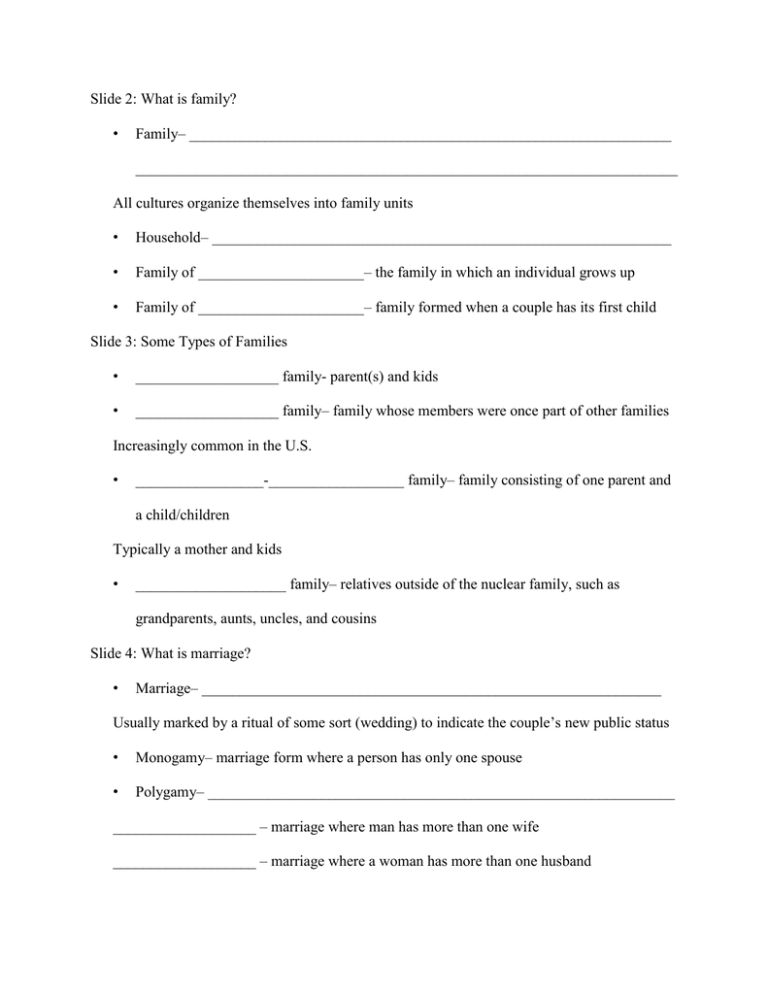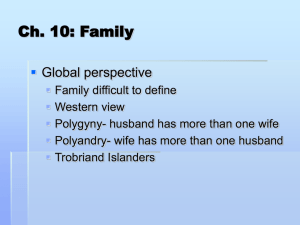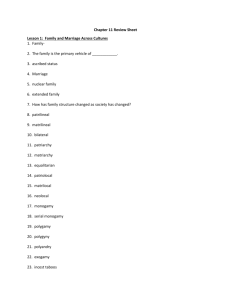
Slide 2: What is family?
•
Family– ________________________________________________________________
________________________________________________________________________
All cultures organize themselves into family units
•
Household– _____________________________________________________________
•
Family of ______________________– the family in which an individual grows up
•
Family of ______________________– family formed when a couple has its first child
Slide 3: Some Types of Families
•
___________________ family- parent(s) and kids
•
___________________ family– family whose members were once part of other families
Increasingly common in the U.S.
•
_________________-__________________ family– family consisting of one parent and
a child/children
Typically a mother and kids
•
____________________ family– relatives outside of the nuclear family, such as
grandparents, aunts, uncles, and cousins
Slide 4: What is marriage?
•
Marriage– _____________________________________________________________
Usually marked by a ritual of some sort (wedding) to indicate the couple’s new public status
•
Monogamy– marriage form where a person has only one spouse
•
Polygamy– ______________________________________________________________
___________________ – marriage where man has more than one wife
___________________ – marriage where a woman has more than one husband
Slide 5: Patterns in Marriage
•
Endogamy– _____________________________________________________________
Religious group, racial-ethnic group, cultural group, etc.
Most common form of marriage
•
Homogamy– ____________________________________________________________
Largely due to propinquity (spatial nearness)
93 percent of Americans marry within their racial-ethnic group
•
Exogamy– ______________________________________________________________
________________ ________________ – prohibits sex and marriage among designated
relatives
Slide 6: Descent
•
System of descent– _______________________________________________________
•
Bilineal system– __________________________________________________________
________________________________________________________________________
•
___________________ system– way of tracing descent that counts only the father’s side
•
___________________system– way of tracing descent that counts only the mother’s side
Slide 7: Authority
•
Authority– ______________________________________________________________
•
___________________ – a group in which men-as-a-group dominate women-as-a-group
Authority is vested in males
•
___________________– a group in which women-as-a-group dominate men-as-a-group
Authority is vested in females
•
Egalitarian–______________________________________________________________
________________________________________________________________________
Slide 8: Marriage & Family: Functionalist Perspective
•
Family is universal because it fulfills 6 basic survival needs:
_______________________ production
_______________________ of children
Care of the sick and aged
_____________________________
______________________ control
Reproduction
•
_________________ _________________ prevents role confusion
Creates need for exogamy
Helps socialize children
Slide 9: Marriage & Family: Conflict Perspective
•
Struggles between spouses are part of married life
•
Power is oftentimes the most contested issues
•
Who makes the decisions at home in U.S. families?
__________%- wife makes more decisions
__________%- couples divide decisions equally
__________%- husband makes more decisions
Slide 10: Marriage & Family: Symbolic Interactionist Perspective
•
Traditional family set-up:
Father worked and made money
Mother in charge of childcare and household chores
•
Current U.S. family set-up:
Fathers spend more time doing childcare and household chores
Mother spends more time at work
•
Trends:
Gendered division of _____________ still exists
Both parents are spending less time at social activities, more at home raising kids
Slide 11: Love, Courtship, & Marriage
•
“Love sickness” is real
Love is addictive
•
Romantic love– __________________________________________________________
________________________________________________________________________
•
Psychologists _____________ ______________and _____________ _______________
found that fear can create attraction (1985)
Romantic love has two components: ___________________ (sexual attraction) and
___________________ (labeling it “love”)
Slide 12: Children and Child-rearing
•
Ideal family size is influenced by age and religious service attendance
Americans 18-34 years old prefer _____________ families
34 years+ prefer ______________ families
Couples who attend more services prefer _____________ families
•
Quality daycare = staff with early childhood development training and low ratio kid to
worker ratio
1/6 kids go to daycare
•
26-40% of kids are cared for by relatives when mother works
Slide 13: US Family Transition #1– Kids Staying Home Longer
•
Kids used to leave home after high school/college
•
Kids now often stay at home during college and beyond
Boomerang children– ________________________________________________
__________________________________________________________________
_________% of Americans ages 25-29 live with parents
•
“Adultolescence”– ________________________________________________________
________________________________________________________________________
Slide 14: US Family Transition #2– Adults Adjusting to Widowhood
•
Women are more likely to outlive spouse
Women tend to live slightly longer than men
Women tend to marry older men
•
Widowhood effect– _______________________________________________________
________________________________________________________________________
Worse in cases of sudden spousal death
Slide 15: African American Families
•
Upper class families of all racial/ethnic backgrounds– focus on preserving privilege and
family fortune
Marriage = merger of family lines
Marry later than other classes
•
Middle class African American families focus on __________________ and
______________________
Both parents likely work outside home
•
Impoverished African American families– very likely to be headed by a woman
Focus on stretching kinship (fictive kin) and sharing resources
Slide 16: Latino/Hispanic Families
•
Country of origin influences likelihood of families being headed by married couple
•
Fathers/husbands play a stronger role in family life than white or black fathers/husbands
Roman Catholic religion common divorce very stigmatized
•
Loyalty to extended families
Obligation to help in time of need
•
Longer a family has been in the US, more it resembles a “typical” middle class American
family
Slide 17: Asian American Families
•
Most likely group to have kids raised by both parents
•
Sociologist ______________ _______________ (1985) identified distinctive traits:
Retain ___________________ values
Humanism
_______________________
Self-________________________
Hierarchy
Respect for _______________________
Moderation
____________________ – each family member owes respect to other family members
Use of ______________ and _______________ to punish
Children of immigrants experience more family conflict and mental health problems
Slide 18: Native American Families
•
Most significant issue that Native American families face: assimilate into dominant
culture or follow traditional values?
Traditional: emphasize distinctive Native American values, often speak native languages
•
Native American parents are typically more ____________________
Avoid ____________________ punishment
•
Elders play extremely active role in their children’s families
Help raise, teach, and discipline grandkids
•
Extended family very important
Slide 19: Couples without Children
•
________% of married women do not give birth
Double the rate of married childless women 30 years ago
•
Childlessness varies with education level and race-ethnicity
More education = less likely to have kids
White women are __________ likely to remain childless
Asian American women are ____________ likely to remain childless
•
Some are infertile, but most childless couples choose not to have kids
Attain a sense of freedom
Postpone date of having a child until impossible or inconvenient
Slide 20: Gay and Lesbian Families
•
Most gay and lesbian couples lack legal rights (either marriages or civil unions) that
support the relationship
•
Main struggles for same-sex couples:
Housework
__________________
Careers
Problems with _________________
Sexual adjustment
Stigma/discrimination
•
Many same-sex couples choose to have children
_________% of lesbian couples, ________% of gay couples have/adopt kids
Slide 21: Changing Timetable of Family Life
•
Average age of first marriage is ________ for women, ________ for men
•
Average woman has her first kid at around age _________
•
Cohabitation–____________________________________________________________
________________________________________________________________________
12x more common now than in 1970
_______% of US kids spend time in a cohabiting family
•
Children of cohabitating couples tend to have more health problems than children of
married parents
Slide 22: Divorce
•
Hard to say what the exact statistic on divorce rates is
2 million couples get married every year, 1 million get divorced
Is the rate 50% then?
U.S. has 60 million married couples, 1 million get divorced every year
Is the rate only 2%?
•
Third way to measure: How many adults have ever been divorced in their lives?
_______-_______% of American adults
Percentage of divorce rates peaks in one’s 50s
Slide 23: Decreasing the Risk of Divorce
•
Some college (vs. high-school dropout) _______% decrease
•
Affiliated with a religion _______% decrease
•
Own parents of one or both spouses not divorced ________% decrease
If both husband and wife come from families with divorced parents, own odds of divorce are
very high
•
Age 25+ at time of marriage (vs. 18 and under) ________% decrease
•
Waiting to have a baby 7+ months after marriage ________% decrease
•
Annual income $25,000+ _______% decrease
Slide 24: One-parent Families
•
Number of kids living in two-parent families has declined
________% of US kids in 1970, _______% in 2010
•
Parents of about ____________________ US kids divorce every year
•
Single women who give birth are waiting longer to marry
_______% of US babies born to unwed mothers
•
________% of kids of divorce live with their mothers
_________-________% of these kids function at the same level as kids from two-parent
families
_________-________% suffer long-term harm
Slide 25: Children of Divorce
•
More likely to have behavioral, mental, sexual, and physical health problems
•
Likelier to drop out and get arrested
•
Higher rates of divorce
Both for themselves and their kids
•
Girls start having sex at earlier age and are more likely to become teen parents
•
Kids adjust the best to divorce when…
Close to both __________________
Experience little conflict
Live with a parent who is making a ______________ ____________________
Have a ________________ __________________ they can count on
Have a consistent ____________________
Parents DON’T try to stick it out “for the kids”
Slide 26: Ex-spouses & Remarriage
•
Divorced ____________ more likely to feel divorce gives a “new chance”
•
Spouse who initiates the divorce gets over it and remarries sooner
•
Often divorce does not mean the total end of the couple’s relationship
•
Most divorcees who remarry do so with other divorced people
___________ more likely to remarry
Young mothers and women with less education are likelier to remarry
Divorcees who bring kids into remarriage have higher divorce rates
Slide 27: Dark Side of Family Life
•
Spousal battering studied recently (2011) by sociologist ___________ _____________
No gender difference in the ________________ of US spousal violence
Concluded that women attack their husbands as often as men attack their wives
Difference in the effects of the violence
_____________ more likely to be seriously injured or killed
•
Child abuse is extensive– 2 million reports filed of abuse/neglect every year
About 800,000 cases are substantiated
Slide 28: Dark Side of Family Life
•
Incest– _________________________________________________________________
•
Most likely to occur in socially isolated families
•
Most common form is older _____________ offender, younger _______________ victim
¾ of the cases, the brother is the offender and is 5 years older than his little sister
•
Most offenders are ________-_______ years old
•
Most victims are under _________ years old
Slide 29: Bright Side of Family Life: Happy Families
•
Sociologist ___________________ __________________ studied traits of happy
families in the US and South America (1992):
Spend a lot of time together
Are quick to express ___________________
Are committed to promoting one another’s __________________
Do a lot of _______________ and ________________ to one another
Are religious (any religion)
Deal with _______________ in a positive manner
Slide 30: Bright Side of Family Life: Happy Marriages
•
_________% of married American couples report that they are very happy
•
Sociologists ______________ _____________ and _____________ _______________
studied traits of happy couples married 15+ years
Think of their spouses as ______________ _______________
Like their spouse as a person
Think of marriage as a ___________-____________ ____________________
Believe that marriage is ________________
Agree with their spouses on ______________ and ______________
Believe that their spouses have grown more ___________________over the years
Strongly want the relationship to __________________
_______________ together






